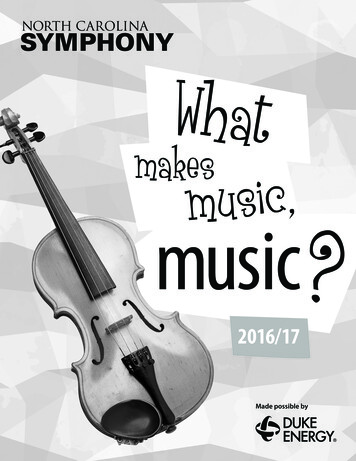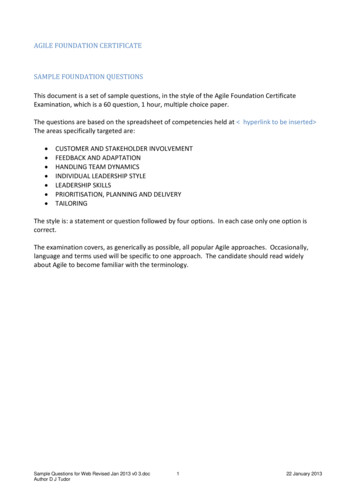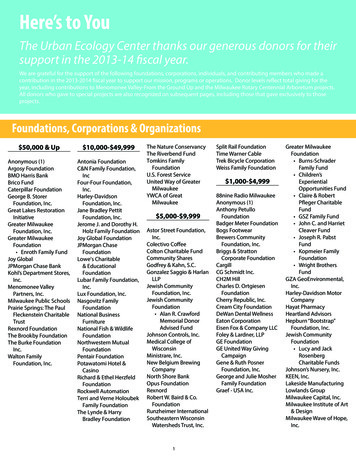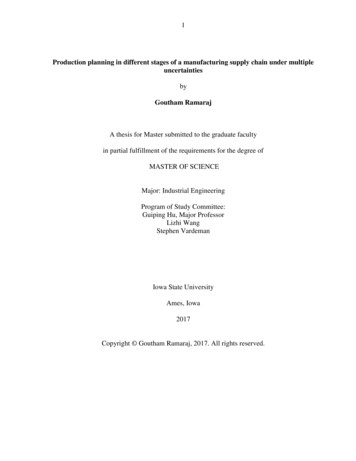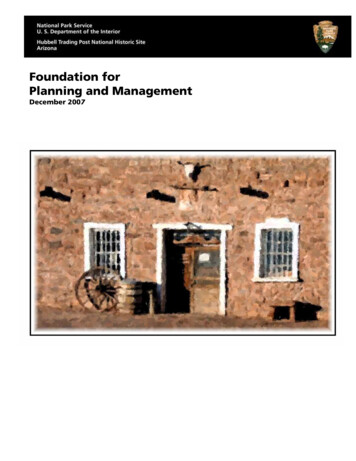
Transcription
Foundation for Planning and ManagementFoundation forPlanning and ManagementDecember 2007
Table of ContentsIntroduction . 1National Historic Site History . 1Part One — Legal Requirements. 3Legislative History . 3Purpose and Significance Statements. 3Primary Interpretive Themes. 5Special Mandates . 6Part Two — Fundamental Resources and Values Analysis. 7Significance Statement 1. Trading Post Operations . 7Fundamental Resources and Values . 7Importance of Fundamental Resources and Values . 8Current Conditions, Related Trends, and Potential Threats . 9Stakeholder Interest . 10Desired Conditions. 11Strategies. 11Relevant Laws and Regulations . 12Existing Planning Guidance. 12Needed Planning and Guidance/Data and Analysis Needs. 12Significance Statement 2. Structures . 12Fundamental Resources and Values . 13Importance of Fundamental Resources and Values . 13Current Conditions, Related Trends, and Threats . 13Stakeholder Interest . 14Desired Conditions. 14Strategies. 15Relevant Laws and Regulations . 15Existing Planning Guidance. 16Needed Planning and Guidance / Data and Analysis Needs. 16Significance Statement 3. Cultural Landscape . 16Fundamental Resources and Values . 16Importance of Fundamental Resources and Values . 17Current Conditions, Related Trends, and Threats . 17Stakeholder Interest . 18Desired Conditions. 19Strategies. 19Relevant Laws and Regulations . 19Existing Planning Guidance. 20Needed Planning and Guidance / Data and Analysis Needs. 20Significance Statement 4. Museum Collection. 21Fundamental Resources and Values . 21i
Importance of Fundamental Resources and Values . 21Current Conditions, Related Trends, and Threats. 22Stakeholder Interest . 22Desired Conditions. 23Strategies . 23Relevant Laws and Regulations . 23Existing Planning Guidance. 24Needed Planning and Guidance / Data and Analysis Needs . 24Significance Statement 5. People. 26Fundamental Resources and Values . 26Importance of Fundamental Resources and Values . 26Current Conditions, Related Trends, and Threats. 27Stakeholder Interest . 27Desired Conditions. 27Strategies . 28Relevant Laws and Regulations . 28Existing Planning Guidance. 28Needed Planning and Guidance / Data and Analysis Needs . 28Next Steps .29Appendix A: Enabling Legislation .31Appendix B: Legislative History .33Appendix C: Legislation and Policies Summary and Descriptions .49Appendix D: Summary and Descriptions of Hubbell National Historic Site ManagementPolicies and Reports .55Appendix E: Planning and Data Needs Summary .67Appendix F: National Historic District Contributing Structures .69Planning Team .71ii
IntroductionThe Foundation for Planning and Managementdocument provides the base upon which allfuture planning efforts are built. Thefoundation document identifies what is mostimportant to the national historic site throughan examination of the establishing legislation,development of purpose and significancestatements and primary interpretive themes,and identification of the special mandates thataffect national historic site management. Thefoundation document also identifiesfundamental resources and values that arecritical to maintaining the national historicsite’s purpose and significance and analyzescurrent and future trends that could affectthose resources and values. Although not adecision document, the foundation documentsets the parameters for future planning andallows National Park Service (NPS) managersto make informed decisions about factors thatare critical to the national historic site’soperations, management, and future.The foundation, as identified in NPS ParkPlanning Program Standards, has the followingelements: Part One — Legal Requirements,which consist of Park Purpose — the specificreason for establishing aparticular parkPark Significance — why a park’sresources and values areimportant enough to warrant aNational Park Service designationPrimary Interpretive Themes —what needs to be interpreted toprovide people withopportunities to understand andappreciate park purpose andsignificanceSpecial Mandates — any speciallegislative or judicialrequirements or administrativecommitmentsPart Two — Analysis of Resources andValues, which includes Analysis of FundamentalResources and ValuesAnalysis of Other ImportantResources and Values1
National Historic Site HistoryHubbell Trading Post National Historic Site(HUTR) is in northeastern Arizona withinApache County. Located just off of ArizonaState Highway 264, the national historic site(NHS) is approximately 1 mile west of Ganadoand 55 miles northwest of Gallup, NewMexico, and is encompassed by the NavajoNation. The national historic site consistsprimarily of a historic vernacular landscapefrom the period that the trading post wasactively run by the Hubbell family — 1878 to1967.The boundary for HUTR NHS is marked(generally) to the east by State Highway 264and the historic irrigation ditch that parallelsan irrigation reservoir on the southeast. Thenorthern and western boundaries are marked(generally) by the Pueblo Colorado Wash. Thesouthern boundary is marked by the fence lineof the national historic site’s southernmostfarm field.The national historic site lies on the ColoradoPlateau, an intensely dissected rocky region ofvarious elevations, ranging from 3,500 feet tomore than 10,000 feet above sea level. Theclimate consists of high summer temperaturesand subzero winter temperatures, high winds,frequent sandstorms, and high evaporationrates. Periodic droughts are common in thearea. All of these conditions make the practiceof agriculture not only a challenge but alsoentirely dependent on the availability ofirrigation water.The natural vegetation in this area consists ofColorado Plateau desert scrub and ischaracterized by piñon pine in the higher moistareas, with lower elevations supportingpiñon/juniper mix. At the lowest elevations,sagebrush is often the only vegetation found.The Pueblo Colorado Wash now cuts throughthe northernmost part of the national historicsite and provides an environment for variousnative and introduced riparian species of floraand fauna. The remainder of the nationalhistoric site consists of leveled terraces, risingfrom north to south, from which nativevegetation was removed for farming andlivestock raising. Some sagebrush and otherdesert scrub vegetation have recolonized thesefields since the cultivation of crops was haltedin the mid-1900s.For many generations, the lands that now makeup the national historic site were used byindigenous people, including the Navajo, whocurrently reside in the area. In 1863, the Navajopeople and other tribes were driven from theirland by Kit Carson and his troops and wereimprisoned by the U.S. Army at Fort Sumner.In 1868, the United States and Navajo tribalrepresentatives signed the first of a number oftreaties that established the boundaries of theNavajo Nation. The Navajo were then releasedfrom Fort Sumner and allowed to return totheir traditional lands.In approximately 1874, an Anglo Europeantrader named William Leonard established atrading post in the Ganado valley. In 1878,under a “squatter’s right,” Juan LorenzoHubbell purchased the Leonard post, thecurrent location of the Hubbell Trading Post,and later filed a homestead claim for theproperty. In 1880 the nearby Navajo Nationlands were expanded, engulfing the Hubbellestablishment. After many years of efforts tosecure the rights to the land, Hubbell finallyreceived a patent for the land in 1917.Consequently, this land became one of the fewprivately owned parcels of land (privateinholding) within the boundaries of the NavajoNation.During the first half of the 20th century, JuanLorenzo Hubbell built an economic empireconsisting of more than 20 trading posts with afreighting operation. Through creativemarketing of native crafts (mainly rugs andsilver) on the east and west coasts, Hubbell wasable to greatly influence the production and1
Foundation for Planning and Managementdevelopment of traditional designs that remainin use today.Hubbell also was involved in local politics andwas an active member of Ganado and otherNavajo communities. Avid collectors, theHubbell family as a whole amassed anextensive and unparalleled personal collectionof fine art, literature, furnishings, and NativeAmerican and prehistoric artifacts. Owing tothe lack of places to stay and the openhospitality provided by Don Lorenzo Hubbell,the Hubbell family home and trading postbecame an important stop for persons travelingthrough the Navajo and Hopi lands. Manyimportant people of the day, includingpresidents, writers, photographers, artists, andarcheologists, stayed at the Hubbell homeduring their explorations of northern Arizona,with some guests returning repeatedly forextended stays. This tradition of hospitalitycontinued under the tenure of Hubbell’s son,Ramon, and Dorothy Hubbell (Ramon’s wife).2During the mid-20th century, the Hubbelltrading empire was reduced primarily to theoperations at Ganado. During the 1960s,Dorothy Hubbell struggled to keep the tradingpost going and to continue to serve herclientele. Through the help of friends at theUniversity of Arizona, the Arizonacongressional delegation, and the Museum ofNorthern Arizona, Dorothy Hubbell was ableto arrange the sale of the trading post to theNational Park Service. In 1965 the nationalhistoric site was authorized by an act ofCongress, and the National Park Service beganadministering the site in 1967, with the intentto keep it an active, traditional trading post.Today, the site is the oldest and longestcontinuously operated trading post in theAmerican Southwest, and it is listed as anational historic landmark.11Excerpts from Hubbell Trading Post Cultural LandscapeReport, Landum 2002
Part One — Legal RequirementsA park unit’s legislative history, purpose,significance, primary interpretive themes, andspecial mandates set the parameters forplanning and operations for each unit of theNational Park Service.Legislative HistoryPublic Law 89-148 established HubbellTrading Post National Historic Site as a unit ofthe National Park Service on August 28, 1965(appendix A). The enabling legislation, whichconsists of three paragraphs, identifies theparcel of land, trading post structures, and thegeneral nature of the buildings’ contents andauthorizes the secretary of the interior topurchase the post. It also provides somefunding for the national historic site’s purchaseand operation. Finally, it provides directionson disposal of any excess lands. The act doesnot specify what the unit’s mission should be,other than to preserve and protect the tradingpost and its contents.Guidance on the national historic site’spurpose is found in the act’s legislative historyand in the site’s administrative history. TheSenate Congressional Record states on August16, 1965, that arrangements should be made to,“have it [Hubbell Trading Post] operate alongthe lines close to that which were in effectwhen it was an active post” (CongressionalRecord — Senate, page 20502). The park’sadministrative history thoroughly documentsthe passage of the House and Senate billsleading to the act and discussions onpreserving it as a “living trading post.” Thisconcept was strongly supported by then NPSDirector George Hartzog. The strong traditionof Hubbell Trading Post National Historic Siteoperating as a living trading post led to a parkmission statement articulated in the unit’s2002–2005 Strategic Plan:The mission of Hubbell Trading PostNational Historic Site is to preserve,protect, and interpret an original Indiantrading post operation and its environs forthe benefit and enjoyment of the public.The trading post is to be conserved as afunctional, viable establishment, reflectingongoing, traditional trading relationships.Purpose and SignificanceStatementsHubbell Trading Post NHS was specifically setaside to preserve and protect the continuum oftrading post operations and its ties to localcommunities and artisans. Statements of theunit’s purpose are grounded in a thoroughanalysis of the national historic site’s legislationand legislative history (appendix B). Thesedocuments help articulate Congress’s rationaleand intent for creating the national historicsite. With input from NPS staff and keystakeholders, the following statements weredeveloped:The purpose of Hubbell Trading Post NationalHistoric Site is to Preserve and protect the historic andcultural contents, structures,functional arrangement, and naturaland cultural landscapes of HubbellTrading Post, including the tradingpost itself, the Hubbell home, thegrounds, and the farm operations,for the public to understand,experience, and enjoy. Conserve and continue HubbellTrading Post as a live, operating,dynamic, and functioning economicand social institution and a way oflife, in the tradition of an earlier eraof Southwest American Indian,Spanish, and Euro-American history. Identify and use Hubbell Trading Postas a preeminent site from which tointerpret and understand the history,culture, and ethnography ofAmerican Indians, particularly theNavajo (Diné).3
Foundation for Planning and Management Preserve the intangible elementsimportant to the heritage andrelationships found in the AmericanSouthwest, such as the links betweencultures and traditions; a place forsocializing, learning, and exchanginginformation; and an atmosphere oftrust and friendship.Significance statements describe why an area isimportant within a global, national, regional,and system-wide context and are directlylinked to the purpose of the historic site. Thesestatements are substantiated by data orconsensus and reflect the most currentscientific or scholarly inquiry and culturalperceptions, which could have changed sincethe park’s establishment. 4Trading Post Operations. HubbellTrading Post is the oldest and longestcontinuously operated traditionaltrading post in the AmericanSouthwest. J. L. Hubbell establishedthis internationally recognized site in1876 as a center of commerce for theNavajo people. Structures. In continual use sincethe 1800s, the masonry and adobebuildings and structures at HubbellTrading Post National Historic Siterepresent styles of workmanshipconstructed from readily availablematerials that reflect various culturalarchitectural traditions. The buildingshave the highest integrity, with themost intact and best examples of anevolving American Southwest tradingpost complex. Cultural Landscape. HubbellTrading Post National Historic Site isan exceptionally intact homesteadrelating to a late 19th-centurytrading post. The landscape includesnatural and cultural features, such asterraced farmlands, authenticbuildings, structures, and objects, andthe Pueblo Colorado Wash. Thelandscape provides a connection thatevokes a strong sense of place.
Part One — Legal Requirements Museum Collection. The HubbellTrading Post National Historic Sitemuseum collection is the largest andmost comprehensive record of atrading business in the AmericanSouthwest. Its combination offurnishings, archives, objects, andoral histories represent the mostcomplete record of a family tradingbusiness and its role in a localcommunity. The museum collection isan essential part of and contributessignificantly to the integrity of theHubbell family trading businessrecord.People. Hubbell Trading Postcontinues to be community focused;a place where traders, NativeAmericans, and patrons (artists,community members, and visitors)can meet to share ideas, socialize,and continue traditional tradingpractices, while also adaptingtraditional trading core values to anevolving and increasinglytechnological and interconnectedworld. This place continues to be acrossroad of culture and settlement.Primary Interpretive ThemesIdentification of primary themes is part of apark’s basic foundation statement. Themes arederived from — and should reflect — parksignificance. Additional perspectives can beobtained from the identification and analysis offundamental and other important resourcesand values. Primary themes should be fewenough in number to provide focus for theinterpretive program, but numerous enough torepresent the full range of park significance.Interpretive theme statements for HubbellTrading Post National Historic Site weredefined in its 2007 Comprehensive InterpretivePlan and are listed below. Every visitor shouldhave the opportunity to explore these themesthrough the park’s personal services programs,the interpretive media, and/or the resourceswithin the national historic site. These themesare critical to public’s understanding of thesite’s significance.1. The stories of this place, beginning longbefore the Indian trader era, provide anopportunity to learn about the lifeways ofSouthwestern Native American tribes, inparticular the Navajo people.2. The history of J. L. Hubbell’s tradingactivities and his trading post speaks tohow successful traders understood andcontinue to understand the criticalimportance of respecting and serving thecommunity. Traders act as keyintermediaries and agents of change amongSouthwest American Indians, Hispanics,and Euro-Americans; understanding thehistory of Indian trading is an importantway to appreciate the history of relationsamong these cultures.3. Hubbell Trading Post National HistoricSite is a living reminder of a time oftransition — when Navajo life evolved froma time of war and conflict to a time ofgreater security and unity of life builtaround community. Hubbell Trading Postcontinues to serve as a community centertoday.4. The long and continuing success of theHubbell Trading Post is the result of thetrader and his/her efforts, working inpartnership with artists, to raise thevisibility and appreciation of their art andgain worldwide recognition. Visitors havethe opportunity to directly interact withweavers and other Native American artiststo help them understand each artist’smethods and motivation and the role artplays in their families, in the community,and the culture overall.5. Hubbell Trading Post National HistoricSite’s cultural landscape — including thebuildings, structures, and agricultural fields— is the finest example of a completetrading post homestead. The nationalhistoric site provides visitors the chance toexperience an authentic operational19th/20th-century southwestern tradingpost.6. Hubbell Trading Post National HistoricSite provides a unique setting forinterpreting traditional trading post5
Foundation for Planning and Managementoperations, the interactions between EuroAmericans and Native Americans(especially the Diné/Navajo) as pertains totrading, and the values associated withthese operations. Hubbell Trading Post isthe only national park system unit in whichvisitors can directly observe and participatein ongoing buying and selling of qualityNative American arts and crafts.Special MandatesSpecial mandates are specific legislative,judicial, or administrative instructions oragreements that directly influence parkoperations. At Hubbell Trading Post NHS,special mandates center on the relationshipbetween the National Park Service and thenonprofit organization Western NationalParks Association (WNPA), formerlySouthwestern Parks and MonumentsAssociation. In this relationship, the businessoperations of the trading post and visitorcenter sales area are the responsibilities ofWNPA. They are required to operate a viableand accountable business that generates asustainable income that benefits the nonprofitorganization and native artisans. The NPS rolein this relationship is to operate the national6historic site by providing interpretive andcuratorial services, maintaining and preservingthe historic structures, and ensuring publicsafety and security.The following agreements reflect this workingrelationship:1985 Cooperating Association Agreement —Guidelines for operating the tradingpost — the agreement stipulates thatoperations will be based on historictraditions at Hubbell Trading Post,while allowing for a continuingevolution of its practices, to ensure theperpetuation of an active trading postfor interpretation to the public.2005 Task Force Report for the Operation ofthe Trading Post at HUTR NHS — thereport recommends the development ofa historic furnishings plan, a scope ofsales statement, and an operations plan(internal standard operatingprocedures).2005 Scope of Sales Statement, HUTR NHS —the statement presented revisedprocedures for trading post operationsto ensure greater accountability andfinancial accuracy.
Part Two — Fundamental Resources and Values AnalysisFundamental resources and values should be arelatively short list of resources or valuesconsidered to be critical to achieving thehistoric site’s purpose and maintaining itssignificance. Fundamental resources andvalues elaborate on what is most importantabout the historic site, to ensure that specificfeatures, systems, processes, experiences,stories, scenes, etcetera, are adequatelyaddressed in planning and management.Identifying the fundamental resources and valueshelps ensure that all planning is focused on whatis truly most significant about the historic site.Because fundamental resources and valuesdirectly relate to the historic site’s purpose andsignificance, the loss ordegradation of theseresources and values wouldcompromise the purposeand significance.For every fundamentalresource and value somebasic analysis wascompleted to identifycurrent conditions,potential threats, the level ofstakeholder interests, andexisting policy guidance.This analysis identifies basicmanagement strategiesand/or those issues thatneed to be resolved before amanagement strategy can beestablished. This basicanalysis also identifiesinformation gaps and theneed for a generalmanagement plan.In some parks, fundamental resources andvalues can combine to create process. Forexample, at the Grand Canyon, time and watercombine in the process of erosion that isfundamental to the park’s purpose andsignificance. At Hubbell Trading Post NHS,physical resources often combine with humanbehavior to create sociocultural processes, suchas trading practices and the relationship amongthe trader, artisans, and local communitymembers. These processes are ephemeral, butthey are at the heart of what “drives” HubbellTrading Post, and they are fundamental to thesite’s purpose.Significance Statement 1. TradingPost OperationsHubbell Trading Post is the oldest andlongest continuously operated traditionaltrading post in the American Southwest. J.L. Hubbell established this internationallyrecognized site in 1876 as a center ofcommerce for the Navajo people.Fundamental Resources and ValuesTraditional trading post operations form afundamental sociocultural process that directlysupports the historic site’s purpose andsignificance. Without these practices — and thesetting in which they occur (specifically, therug room, trader’s office, bullpen, wareroomand the rugs, paintings, silver jewelry, weavingrelated supplies, and groceries they contain —Hubbell Trading Post would cease to be7
Foundation for Planning and Management Hubbell Trading Post. During the analysis ofthis fundamental value, three relatedsubproc
Hubbell family as a whole amassed an extensive and unparalleled personal collection of fine art, literature, furnishings, and Native American and prehistoric artifacts. Owing to the lack of places to stay and the open hospitality provided by Don Lorenzo Hubbell, the Hubbell family home and tr



